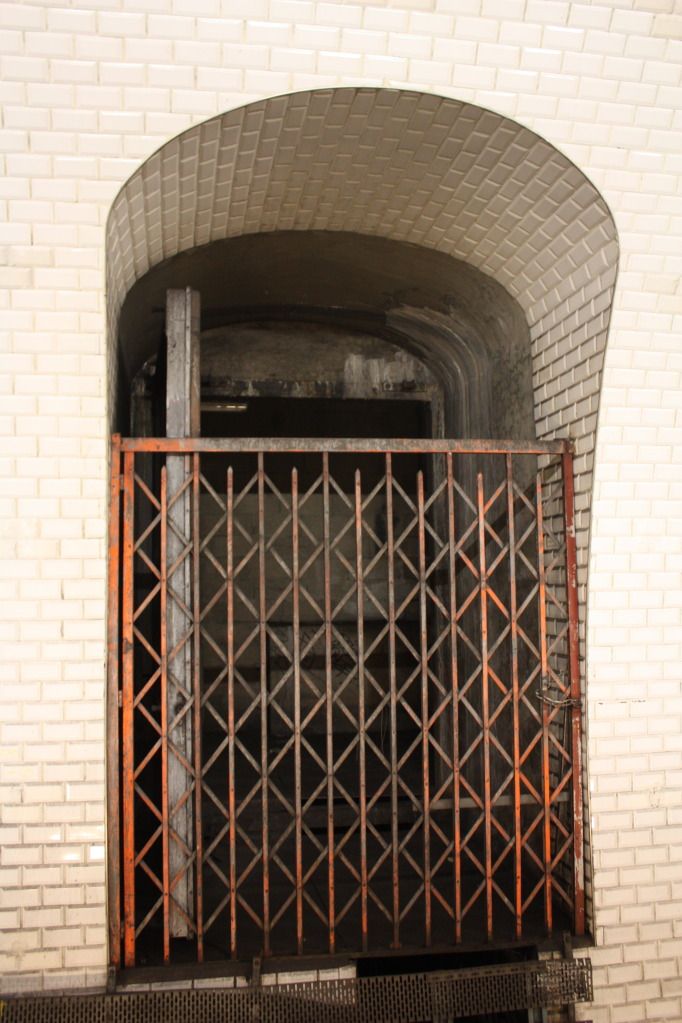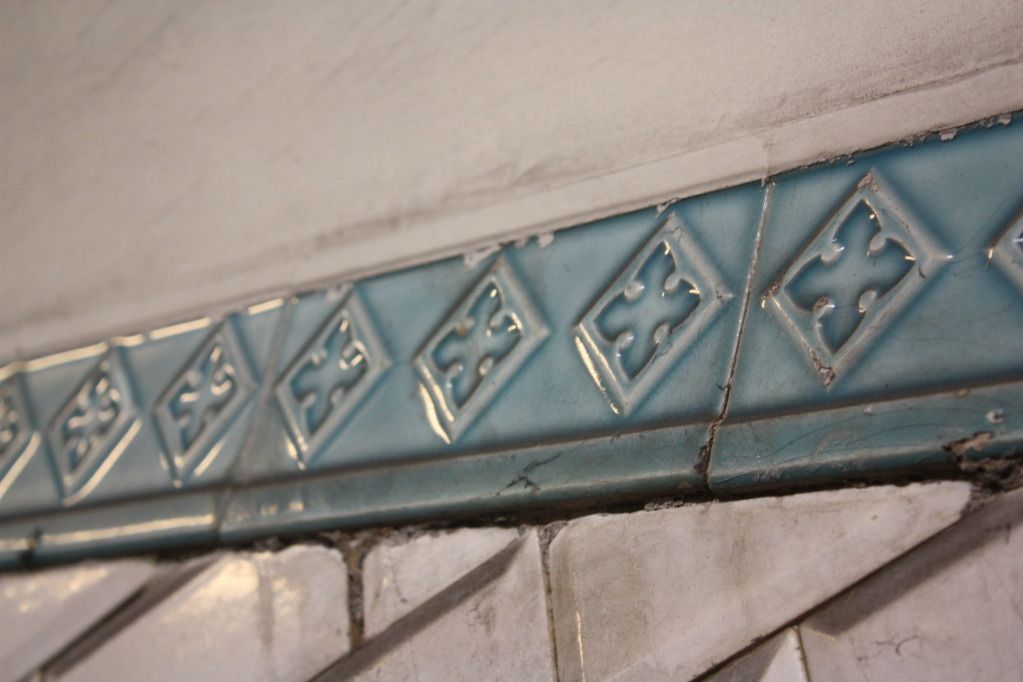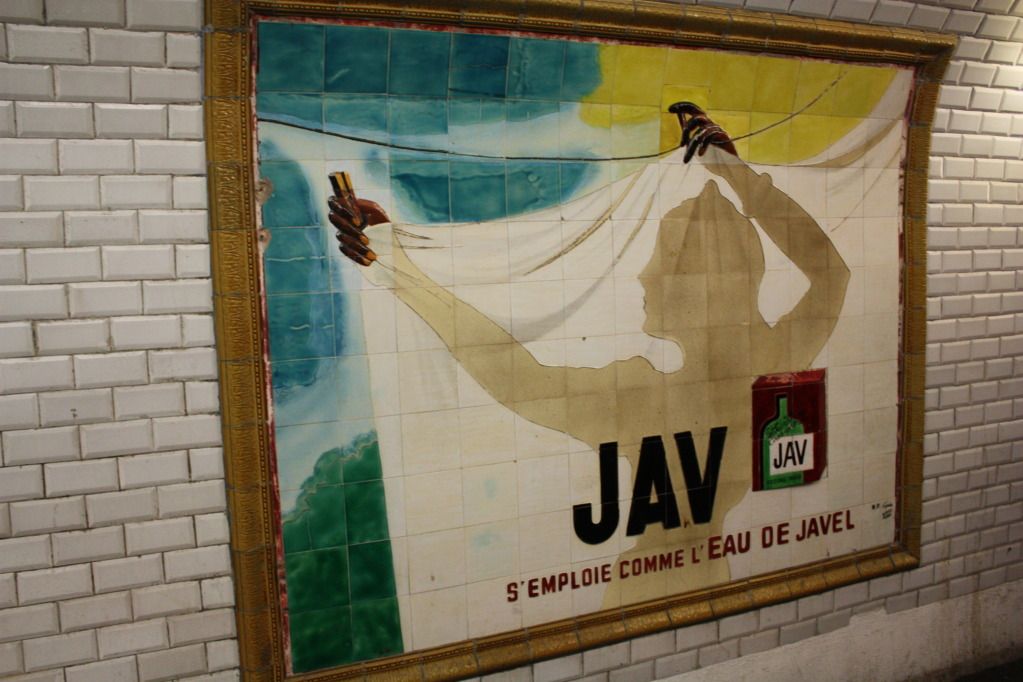I had been searching for an official Paris metro tour through the RATP or other organizations since I arrived in Paris. With no luck, I let it go for a year or so without looking back. Then, last October or so we found that ADEMAS (Association d'Exploitation du MAtériel Sprague) occasionally offers half day tours of the metro..known and unknown. They are a group of unofficial metro buffs who spend the occasional Saturday giving tours and educating the most interested of patrons on the transportation network.
We started off at the Saint-Opportune exit of Châtelet (the largest underground station in the world), meeting our group of about 20 other members. They were mostly older, but quite a mix of men and women. We had a brief history lesson then started on our journey.
Paris was the first city to imagine such a complex world of underground transportation but the first people to implement that idea? The English. (The London underground electric lines were completed in 1890.) The engineers and citizens of Paris couldn't agree on any ideas or plans for the metro which delayed the project even further. They wanted to build the metro going through the buildings already built of Paris because of their fear of the underground world of Paris. With the sickness outbreaks from the water contaminated caused by the catacombs to the idea of so many millions of bones being under the city, it was a reality they didn't want to deal with just yet. How would electricity be reached underground? They had their rightful concerns.
The construction for the Paris metro began in 1896, by the company CMP (Compagnie du chemin de fer métropolitan de Paris). 4 years later the first line was completed that ran east to west from Porte Maillot to Porte de Vincennes the completion being rushed for the World Fair in July of 1900. It took almost an hour and a half to get from one side to the other. How many passengers did the first metro carry its first voyage out? 1. One lonely person was brave enough to ride the first time out. There was controversy over the design of metro entrances, the writing was too "devilish" and the green color of the iron is the color of the Germans, which at that time, was of great concern. The changing of the entrances was going to cost another 4 million euros so the change was put aside, and some entrances (such as the access Guimard, who designed the entrances) are now even considered national historical monuments. Shortly after line one was completed, the CMP was joined by another company, Nord-Sud (Société du chemin de fer électrique souterrain Nord-Sud de Paris). Between the 2 companies, the first 10 lines of the underground metro of Paris were completed by 1920, many have been extended since then. The first ticket cost .45 francs (less than 10 cents) and had an unlimited time limit. Now, a metro ticket costs 1.70 euros and has a 90 minute time limit.
After our basic history lesson at Access Guimard, we headed off to our next entrance passing this store along the way. I have seen it recently, and have been trying to figure out where it is but I was just so lucky we passed it that day! ha! This store was the inspiration for the scene in...yes, you guessed it, Ratatouille. There are about 20 rats hanging in giant traps in the window, but with a city with such a rat problem...someone like this is necessary. The owner of Julien Aurouze & Co. says she will never take down the rats, as they are a symbol of the family business, and what make the shop so famous.
 |
| Pretty gross, no? |
We descended into a different access at Châtelet, and were whisked away to the world of underground tunnel magic. This tunnel archway below, is the oldest tunnel in Paris, dating back to 1642.
The white tiles are unique to the Paris metro and were chosen to provide a clean, hospitable, and well-lighted environment. There weren't quite so many lights in 1900 as we have now, and the white tile reflected what little light existed so that passengers could feel safe and could be easily cleaned.
 |
| Cité. A station that I have been in a dozen times at least, and can honestly tell you I have never noticed the beautiful lighting! It was designed to reflect the lighting on the streets. |
As we moved from one station to the next over the next 3 hours, we learned about the choice of green and brown borders of the advertisement frames to coincide with Nord-Sud's choice of decoration. Brown accent tile indicated a normal station, green accent tile for terminal and transfer stations, and blue for Madeleine. There were more advertisements seen in the metro in the early 1900's than we see today. There were advertisements on your ticket, down inside the voie, on the platform frames, as well as inside the metro.
The trains of the Paris metro were the first to have the rubber tire design in the 1950's. The wheels are covered with a rubber tire that run on rolling bars inside the guide bars for traction, and, for security if the rubber tires are busted or deteriorated, the train can still run on the steel tires underneath. The track carrying the electricity for the trains carries 750 volts. The oldest train operating in existence today dates from 1949 and runs on the line 4. Line 4 trains are quickly being replaced by the old line 1 trains as line 1 is on its way to becoming completely automatic, like the newly built line 14 which was completed in 1998.
Lines 1 and 4 are the most frequented by Parisians. Line 1 carries most of its passengers during rush hours and out to La Défense, and line 4 has a constant flow of passengers all day long and was the first line to cross the Seine. An average of 6.4 million passengers ride the Parisian metro network on any given day. Around 200 people a year commit suicide on the metro, a number that just can't be brought down no matter how many measures are taken to prevent it. Line 9 was the first line to be extended into the suburbs.
Because of the war, many stations were used as bomb shelters and several never reopened because of the close proximity of other stations and the opportunity to cut budgets. Paris has one of the tightest woven rail networks in the world, with the distance between each station having an average of 500 meters. Two stations were built and never opened, one in the 19th arrondissement near Place des Fêtes and one in the 16th near Parc des Princes because they didn't have an access leading in or out. They are completely closed in. There are also 3 metro stations completed in the suburbs in the 1990's, but were never put on the circuit because the connecting stations were never built. The ADEMAS tour guide had photos of these stations and they are swanky! Automatic doors, glass escalators, new trains, and television screens along the platforms are all part of the empty stations at Parc des Expositions, Roissy, and Noisy-le-Grand. Seems like a waste of money to me! In the entire "metro" system, not including the RER system, there are 14 main lines, and 2 shorter lines: the 3bis and the 7bis. The 3bis is the shortest line on the system 1.300 kilometers.
 |
| This tunnel at Place des Fêtes (on the 7bis) was once used as an escape route and as a route to safety during the war. Behind this wall is a large room which can hold up to 1000 people. |
 |
| Pre-war entrances to Place des Fêtes. |
 |
| Part of the entrance before line 11 was added and 7bis became its own line. |
 |
| Beautiful blue tile hidden in the old entrance of Place des Fêtes. |
 |
| Secret passageways. |
Then, one of the most anticipated stations of the journey, one of the old, abandoned, phantom stations, Saint-Martin. The station was closed in 1939, over 60 years ago, 8 months before the German invasion and remained closed until the liberation of Paris in August of 1944. It was re-opened, but the re-opening was short lived because it was so close to the surrounding stations.
Unfortunately, I will say that this station was a bit of a let-down. Since there are still trains running through the platform (that don't stop) the RATP has blocked off the platform so you cannot see. We were taken down a hallway to the open part of the platform, to admire these original advertisements dating from 1948. Because the advertising business was in such bad shape after the war, they decided that this station would be an "example" station and companies could put up their advertisements as an example of what companies could buy in the way of advertising. The company would have paid an annual fee, and were semi-permanent advertisements made of hand painted ceramic tile. The station was closed so shortly thereafter that none of these advertisements were ever seen by the public. The first product, Maizena is a brand of corn flour that still exists today.
The second is for Eau de Javel, a brand of bleach. It depicts the silhouette of a black woman, hanging a white sheet on a clothesline. You can see her hands, and as she uses the bleach, she becomes white. At the time this advertisement was made, France still had its colonies in Africa. We all agreed that this isn't an advertisement that would go over well today.
 |
| It's beautiful, isn't it? It's ashame some of the advertisements I see now....they should have kept them all like this! |
Lines 8 and 9 still pass through the abandoned platforms every 4 minutes. The platform where we ended our tour is now a small day shelter to the homeless, where they can get a quick meal and a shower, and is managed by the Salvation Army.
The network has over 132 miles of track, 300 stations, and 384 stops. It is the second busiest metro system in Europe, second only to Moscow. The RATP which manages all official metropolitan transport was created in 1948 by the joining of the assets of the CMP and the STCRP (Société de Transports en Commun de la Région Parisienne), which managed the city's bus system. The RATP continues to be the hierarchy of Parisian transport, with 45,000 employees.
After our excursion my brain was exhausted. I realized how little the Paris metro has changed in the past 100 years, and how fascinating it is that so many things about it still remain from the 1930's and 40's. I loved every little fact and figure we were given, and only hope I was able to convey them here in a jumbled mixture of thoughts and words. It was a tour I will never forget, and I can now answer just about any Jeopardy question on the Paris Metropolitan network, if that shall ever come into use.
It's beginning to stay light longer which makes me one happy camper! Right now its 6:52 pm here and the sun is just now setting over l'Arc de Triomphe outside the window. Summer is coming! I know those of you in the United States had daylight savings time last night, but we still have 2 weeks to go! I am waiting in anticipation until I can spend hours upon hours picnicking each evening in front of la Tour Eiffel with my friends. It's going to be a wonderful spring à Paris! I can feel it!









No comments:
Post a Comment